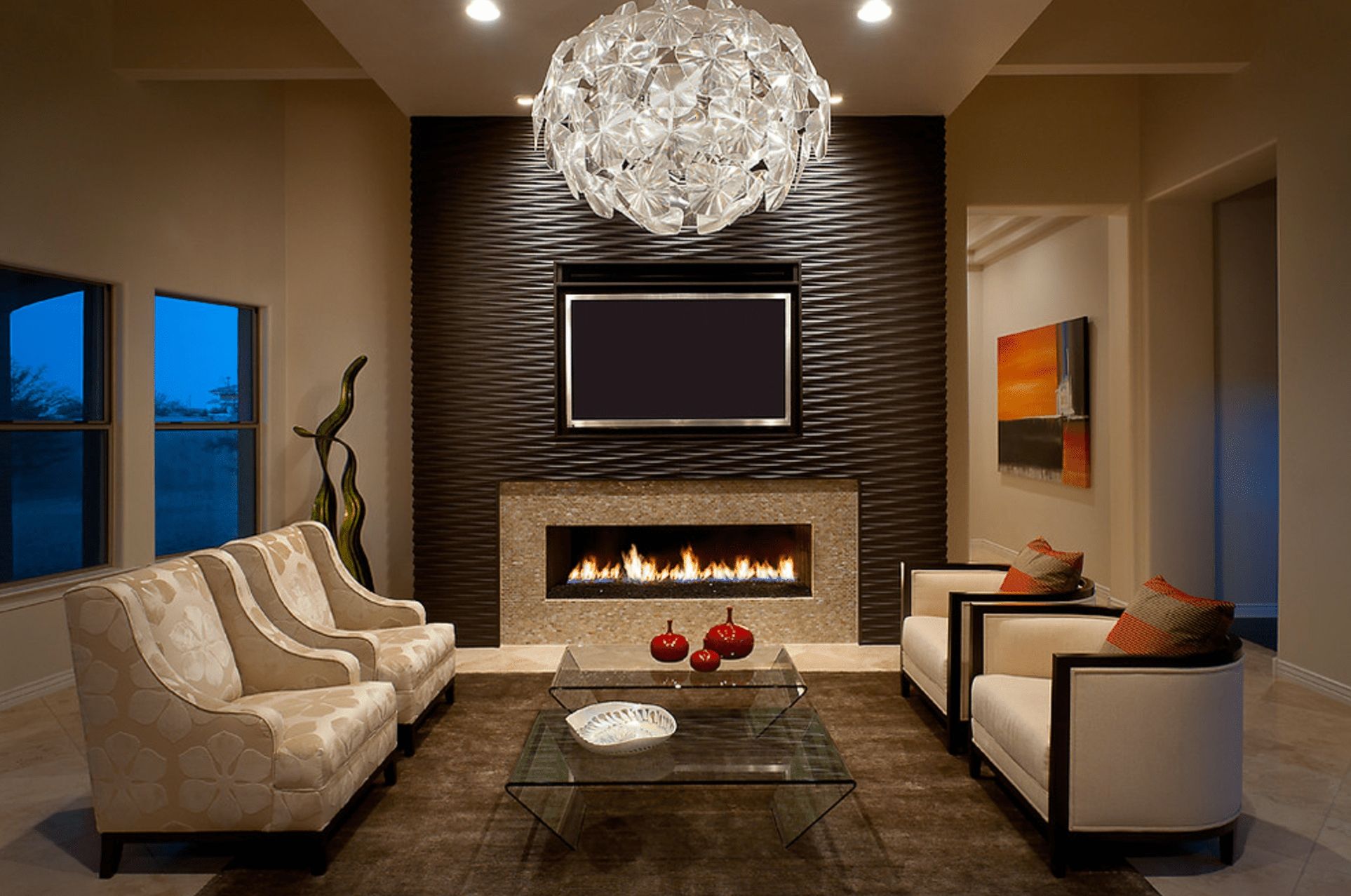The first of top 10 art deco house designs is Philip Johnson's Glass House. Located in New Canaan, Connecticut, Philip Johnson designed this house in the style of a modernist box. It offers a unique combination of light, space and air. It features floor-to-ceiling glass walls and windows to bring in plenty of natural light and an expansive view of the surrounding green space. The interiors of the Glass House connect with the exterior, providing a sense of openness and freedom. Further, the exposed brick walls add a sense of warmth to this modernist structure.Glass House by Philip Johnson
Another classic example of modernist architecture is the Stahl House by Pierre Koenig. Built in 1960 in Los Angeles, California, this two-story mid-century modern structure was designed for Stahl family and is currently considered to be one of the most iconic buildings from the era. It's simple design, with it's white walls and minimal detailing, and indoor-outdoor living structure gives it an airy and luxurious feel and make it an emblematic example of modern art deco architecture.Stahl House by Pierre Koenig
Frank Lloyd Wright's Fallingwater stands in contrast to the stark modernism of the first two designs. Built in the 1930s, on a waterfall in southwestern Pennsylvania, this sprawling, three-story house has come to define "organic" architecture. Fallingwater was constructed from a variety of materials, including local sandstone, glass and copper. The house blends naturally into the forests and rocky terrain of southwestern Pennsylvania, with enormous windows, exposed wooden beams, terraces and gardens. It remains one of the most recognized examples of art deco design.Fallingwater by Frank Lloyd Wright
In the early 1930s, architect Richard Neutra designed the Neutra VDL Research House for his friend, philanthropist Dr. Robert Alexander. Located in Los Angeles, California, the house was meant to explore the principles of modernist architecture. The house combines Neutra's principles of "light, air and nature," in a remarkably open and airy structure. With a flat roof and large windows, the interior is flooded with natural light. This, combined with the large terrace and an enclosed garden, offers a wonderful blend of indoor and outdoor living.Neutra VDL Research House by Richard Neutra
Tadao Ando's Wall House, located in Nishinomiya in Japan, is an elegant example of modernist architecture. Designed in 1975, the house was based on Ando's theory of the 'box and void' approach to house design. The house features concrete walls, with three levels of living space accessed by an enormous wooden staircase. Throughout the interior, there is a strong sense of minimalism and openness, as the walls or 'boxes' separate and structure the living space in a modular manner. The walls also have recessed alcoves, lending a certain warmth and intimacy to the space.Tadao Ando's Wall House
One of Frank Lloyd Wright's most iconic residential designs is the Robie Residence in Chicago, Illinois. This two-story design features strong horizontal lines to reinforce its connection to the prairie of the Midwest. The horizontal lines are further emphasized by the roof, which sweeps over the house like a low-hanging cloud. The low and sprawling design creates a distinct contrast from the more traditional, vertical, Victorian style homes that dominated the city at the time. It is considered to be one of the most important residential designs of the 20th century.Robie Residence by Frank Lloyd Wright
Casa Milà, designed by the famous Spanish architect Antoni Gaudí, is located in Barcelona, Spain. This sprawling house was built in the early 1900s and features a combination of modernist and organic elements. The circular and flowing design is indicative of Gaudí's neo-Gothic style, where geometry, form and light were used to create unique designs. Gaudí was heavily influenced by nature, and this is evident in the whimsical facade, curved towers and the undulating, tiled roof. Casa Milà remains one of his most iconic designs.Casa Milà by Antoni Gaudí
Habitat 67, designed by Israeli-Canadian architect Moshe Safdie, was built in 1967 for the World Exposition in Montreal, Canada. It was meant to explore the concept of a "vertical neighborhood" and offer a unique combination of individual living spaces and communal areas. The design features modular units stacked to form a three-dimensional structure that resembles a crystalline form. The structure is composed of 418 prefabricated boxes constructed from pre-stressed concrete and glass. It remains an icon of modern art deco architecture.Habitat 67 by Moshe Safdie
Located in Columbus, Indiana, The Miller House was designed by the master of modernist architecture, Eero Saarinen. It features a simple and elegant design that comes from an ingenious use of materials. Saarinen employed reinforced concrete and teak throughout the house to create a visually striking structure. But what makes the house so novel is its creativity with shapes and surfaces. The exterior has an undulating roofline, while the entrance is marked with an enormous curved wall that creates both an unexpected form and an intimate atrium.The Miller House by Eero Saarinen
Finally, Sagaponac House, designed by Steven Holl in 2008, is a unique and contemporary example of art deco architecture. The house is composed of two parallel rectangular blocks that create a space for an enclosed outdoor courtyard. The use of concrete and glass create a unique organic form that naturally fits into its coastal New York environment. While the first level of the house features a minimalist design with white walls and wooden floors, the second story features dramatic curves and curved windows.Sagaponac House by Steven Holl
Studio Designs: An Introduction to Iconic House Design
 Studio Designs are a form of iconic house design that has revolutionized modern architecture. These homes emphasize a modern aesthetic, bringing together leading edge thinking and design to create living spaces that are not only visually stunning but comfortable and livable. Whether it comes to building a custom-made studio design
house
, creating a multi-level home or simply personalizing your preexisting residence, leading
architects
and designers can provide innovative and adaptable solutions that are uniquely tailored to fit your needs.
Studio Designs are a form of iconic house design that has revolutionized modern architecture. These homes emphasize a modern aesthetic, bringing together leading edge thinking and design to create living spaces that are not only visually stunning but comfortable and livable. Whether it comes to building a custom-made studio design
house
, creating a multi-level home or simply personalizing your preexisting residence, leading
architects
and designers can provide innovative and adaptable solutions that are uniquely tailored to fit your needs.
What are the Benefits of an Iconic House Design?
 Studio Designs provide an
elegant
and stylish living area that can effortlessly integrate into your lifestyle. These
houses
feature smooth lines and clever use of space, maximising the potential of any space, while creating a contemporary atmosphere.
In addition, these designs are known for their minimalist designs and maximum efficiency, providing a clutter-free home that makes the most of natural light and comfort. Iconic house designs also often feature innovative storage solutions and practical furniture that serve their purpose without compromising on design.
Studio Designs provide an
elegant
and stylish living area that can effortlessly integrate into your lifestyle. These
houses
feature smooth lines and clever use of space, maximising the potential of any space, while creating a contemporary atmosphere.
In addition, these designs are known for their minimalist designs and maximum efficiency, providing a clutter-free home that makes the most of natural light and comfort. Iconic house designs also often feature innovative storage solutions and practical furniture that serve their purpose without compromising on design.
Creating Your Perfect Home
 The artistry and craftsmanship of these homes lend themselves to the
personalisation
of your living area. Leading architects and designers are able to make adjustments to existing plans to make sure each home is unique and personalised to meet the individual needs and preferences of its occupants. This ensures that studio designs are always highly functional and exceptionally beautiful.
For those wishing to go down the custom-made route, it is often possible to completely personalise your home to suit your lifestyle. While these projects are often more labour-intensive, many architects are able to design homes tailored to meeting even the most demanding requirements and specifications.
The artistry and craftsmanship of these homes lend themselves to the
personalisation
of your living area. Leading architects and designers are able to make adjustments to existing plans to make sure each home is unique and personalised to meet the individual needs and preferences of its occupants. This ensures that studio designs are always highly functional and exceptionally beautiful.
For those wishing to go down the custom-made route, it is often possible to completely personalise your home to suit your lifestyle. While these projects are often more labour-intensive, many architects are able to design homes tailored to meeting even the most demanding requirements and specifications.
Finding the Right Architect for Your Iconic House Design
 To ensure you get your perfect home, it is essential to find an experienced and reliable architect. Doing your research is essential, checking the backgrounds and portfolios of candidates to make sure they are a good fit for your project. With the right team on your side, your iconic house design can become a reality.
To ensure you get your perfect home, it is essential to find an experienced and reliable architect. Doing your research is essential, checking the backgrounds and portfolios of candidates to make sure they are a good fit for your project. With the right team on your side, your iconic house design can become a reality.

































































































































